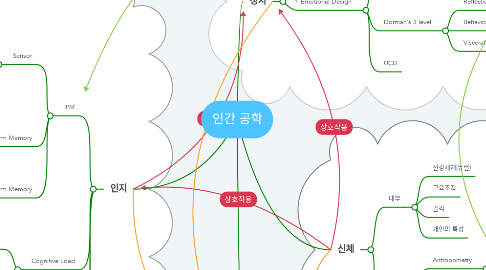
1. 신체
1.1. 내부
1.1.1. 신경체제(뉴런)
1.1.2. 근육조직
1.1.3. 골격
1.1.4. 개인의 특성
1.2. 외부
1.2.1. Antropometry
1.2.1.1. 외부 환경과의 상호작용
1.2.1.1.1. 환경적 변수
1.2.1.1.2. 환경적 특성
1.2.2. Human Factor_Physical
1.2.2.1. 일의 편리
1.2.2.2. 일의 안전
1.2.2.3. 일의 효율
2. 정서
2.1. Emotional Design
2.1.1. Positive Design
2.1.1.1. Why not change the world?
2.1.1.2. Authentity
2.1.1.3. Definition of Positive
2.1.2. Dorman's 3 level
2.1.2.1. Reflective
2.1.2.1.1. 브랜드 Identity
2.1.2.2. Behavioral
2.1.2.3. Visceral
2.1.3. UCD
3. 인지
3.1. IPM
3.1.1. Sensor
3.1.1.1. 오감
3.1.1.1.1. 미각
3.1.1.1.2. 청각
3.1.1.1.3. 후각
3.1.1.1.4. 시각
3.1.1.1.5. 촉각
3.1.2. Short -term Memory
3.1.2.1. 망각
3.1.2.2. 기억
3.1.2.2.1. 반복
3.1.2.2.2. 감정의 결합
3.1.3. Long-term Memory
3.1.3.1. 인출
3.1.3.2. 저장
3.2. Cognitive Load
3.2.1. Cognitive Skill
3.2.1.1. 스키마 형성
3.2.1.2. 꾸준한 숙련 (독서)
3.2.1.3. 자극 분할 (메모 등)
3.2.2. Human Error
3.2.2.1. 과부하
3.2.2.2. 실수, 망각
3.3. Human Factor_Psychological
3.3.1. 타인과의 상호교류
3.3.2. 학습
3.4. UCD
4. 사람, 곧 사용자 중심
4.1. Usefulness
4.1.1. Utility
4.1.2. Usability

